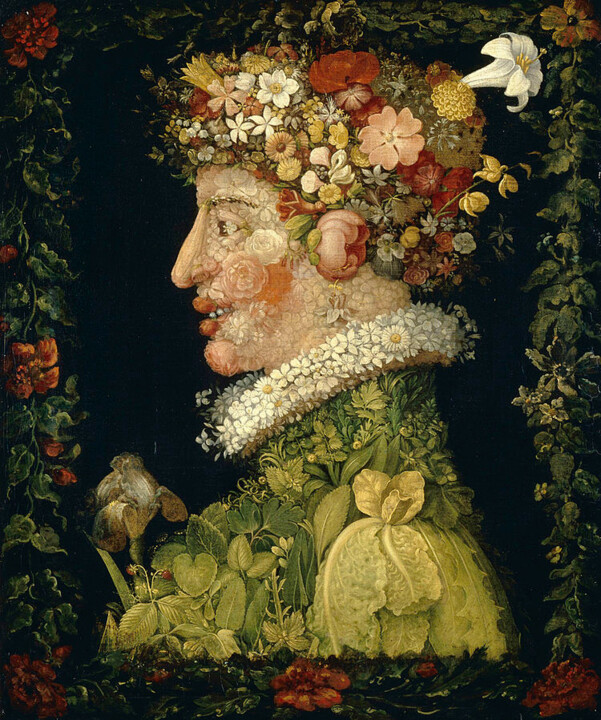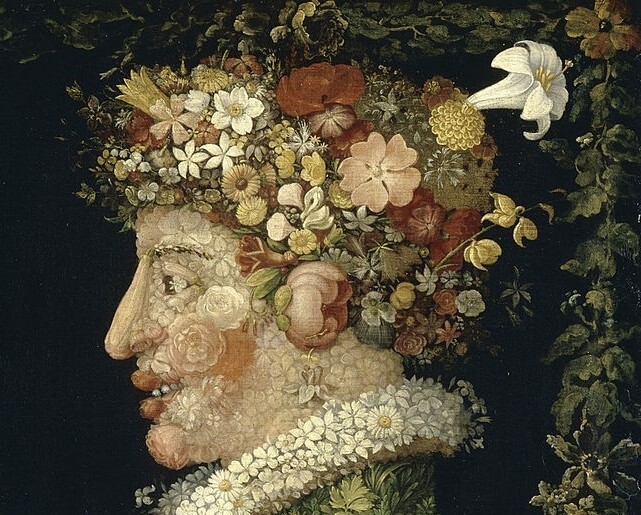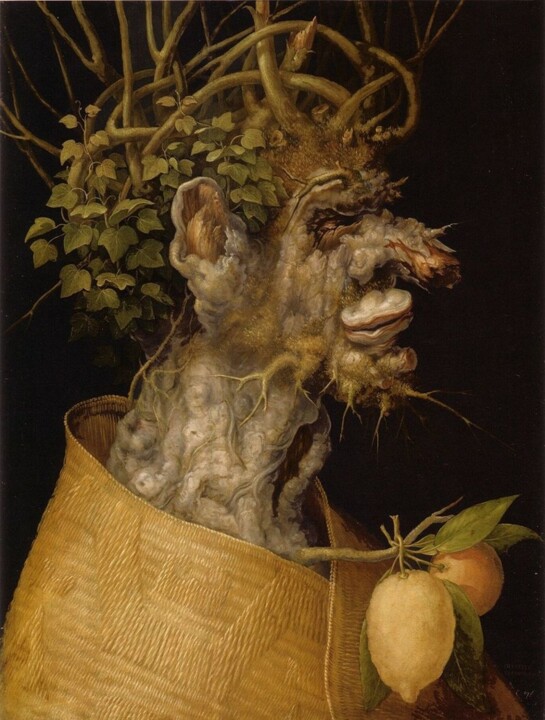 Giuseppe Arcimboldo, Self-portrait, Prague: Národní galerie.
Giuseppe Arcimboldo, Self-portrait, Prague: Národní galerie.
Who was Giuseppe Arcimboldo?
Giuseppe Arcimboldo was an Italian painter from the late Renaissance period who lived from 1527 to 1593. He is known for his imaginative portrait paintings that were composed entirely of fruits, vegetables, flowers, and other natural objects.
Arcimboldo was born in Milan and studied under his father, a painter and miniaturist. He later worked in the court of the Holy Roman Emperor in Vienna and Prague, where he created many of his most famous works. His portraits were often whimsical and playful, featuring faces made up of objects such as fish, books, and musical instruments.
Arcimboldo's work was highly original and influential, and he is considered a pioneer of the genre of still-life painting. His paintings were appreciated during his lifetime and continue to be celebrated for their creativity and technical skill. Today, his works can be seen in museums and galleries around the world, including the Louvre in Paris and the Kunsthistorisches Museum in Vienna.
 Giuseppe Arcimboldo, Vertumnus, 1590. Oil on panel, 70×58 cm. Håbo: Skokloster Castle.
Giuseppe Arcimboldo, Vertumnus, 1590. Oil on panel, 70×58 cm. Håbo: Skokloster Castle.
How to describe Arcimboldo style in five points?
Giuseppe Arcimboldo was a 16th-century Italian painter who was famous for his unusual and distinctive style. Here are five key points to describe his style:
- Mannerism: Arcimboldo's style was heavily influenced by the Mannerist movement, which was popular in Europe during the 16th century. This style was characterized by its highly stylized and exaggerated features, as well as its use of intricate and complex designs.
- Composite portraits: Arcimboldo is best known for his composite portraits, which were made up of a variety of objects arranged to resemble the features of a human face. He used a wide range of objects, including fruits, vegetables, flowers, and animals, to create these portraits.
- Surrealism: While surrealism as a movement did not exist during Arcimboldo's time, his work has been described as surreal because of its dreamlike quality and use of unexpected and illogical combinations.
- Symbolism: Arcimboldo's work often included hidden symbols and references to political and social issues of the time. For example, his portrait of Rudolf II included various symbols of alchemy and the occult, which were of particular interest to the emperor.
- Playfulness: Arcimboldo's work often had a whimsical and playful quality, as he enjoyed creating images that were both entertaining and thought-provoking. His composite portraits, in particular, often had a humorous and lighthearted quality that appealed to audiences of all ages.
 Giuseppe Arcimboldo, Flora, c. 1589, Oil on panel, 73 × 56 cm. Private collection.
Giuseppe Arcimboldo, Flora, c. 1589, Oil on panel, 73 × 56 cm. Private collection.
What were the most recurrent subjects of his work?
The most recurrent subjects of Giuseppe Arcimboldo's work were his famous composite portraits, which he created by arranging a variety of objects such as fruits, vegetables, flowers, and animals to create the illusion of a human face. He produced a series of these portraits, including portraits of emperors, seasons, elements, and even grotesque portraits. Additionally, Arcimboldo also created allegorical paintings that represented abstract concepts such as Fire, Water, Earth, and Air, and he often included hidden symbols and references to political and social issues of his time in his work.
 Giuseppe Arcimboldo, Spring, 1563. oil on canvas, 76 x 64 cm. Paris: Louvre.
Giuseppe Arcimboldo, Spring, 1563. oil on canvas, 76 x 64 cm. Paris: Louvre.
The Spring by Arcimboldo Giuseppe
Arcimboldo's Spring is one of his most famous composite portraits, which he painted as part of a series of four portraits representing the seasons. In this painting, Arcimboldo used a variety of flowers, leaves, and branches to create the illusion of a human face. The face is surrounded by a colorful array of blooming flowers, which represent the arrival of spring and the renewal of life after the long winter months. The portrait is characterized by its playful and whimsical quality, as well as its intricate and detailed composition. Arcimboldo's Spring, along with his other seasonal portraits, has become a symbol of the changing of the seasons and the beauty of nature.
 Detail of: Giuseppe Arcimboldo, Spring, 1563. oil on canvas, 76 x 64 cm. Paris: Louvre.
Detail of: Giuseppe Arcimboldo, Spring, 1563. oil on canvas, 76 x 64 cm. Paris: Louvre.
What is the description of Arcimboldo's Primavera?
"Primavera" is the Italian word for "spring", and it is also the title of a famous painting by Giuseppe Arcimboldo. The painting, known as Arcimboldo's "Primavera", is a composite portrait that depicts the arrival of spring and the renewal of life.
In this painting, Arcimboldo uses a variety of flowers, leaves, and branches to create the illusion of a human face. The face is surrounded by a colorful array of blooming flowers, which represent the awakening of nature after the long winter months. The flowers are arranged in such a way that they create the impression of hair and eyebrows.
The portrait is characterized by its playful and whimsical quality, as well as its intricate and detailed composition. The colors are vibrant and lively, and the overall effect is one of joy and celebration.
Arcimboldo's "Primavera" is considered a masterpiece of the Renaissance era, and it continues to be admired for its creative and innovative approach to portraiture. It has become a symbol of the beauty and vitality of springtime, and it is widely recognized as one of Arcimboldo's most iconic works.
What is the meaning of Arcimboldo's Spring?
The meaning of Arcimboldo's Spring, like many of his composite portraits, can be interpreted in different ways. One interpretation is that the painting represents the arrival of spring and the renewal of life after the cold and dark winter months. The colorful array of flowers and foliage that make up the face of the portrait symbolize the awakening of nature and the joy that comes with the changing of the seasons.
Additionally, some art historians see Arcimboldo's Spring as a celebration of the beauty and diversity of nature. By creating a face out of a variety of different flowers and plants, Arcimboldo highlights the richness and complexity of the natural world.
Finally, like many of Arcimboldo's works, there may be hidden meanings or political allegories embedded in the painting. For example, some have suggested that the portrait may have been created as a tribute to Rudolf II, the Holy Roman Emperor, who was known for his love of botany and the natural sciences.
Overall, Arcimboldo's Spring is a joyful and whimsical work of art that celebrates the beauty of nature and the changing of the seasons. Its meaning may be open to interpretation, but its vibrant colors and imaginative composition continue to captivate viewers today.
 Giuseppe Arcimboldo, Winter (1563). Vienna: Kunsthistorisches Museum.
Giuseppe Arcimboldo, Winter (1563). Vienna: Kunsthistorisches Museum.
Are there other works dedicated by Arcimboldo to the seasons besides Spring?
Yes, the Italian painter Giuseppe Arcimboldo created a series of paintings dedicated to the seasons, including Spring, Summer, Autumn, and Winter.
Each painting depicts the season using a combination of human and natural elements, such as flowers, fruit, and vegetables, arranged in a way that creates the illusion of a portrait.
In addition to the Seasons series, Arcimboldo also created other themed series, such as the Elements (depicting fire, water, air, and earth) and the Four Seasons in the South (depicting the effects of the seasons on southern Italian landscapes).
 Giuseppe Arcimboldo, Four Seasons, 1563. Oil on panel, 66 × 50 cm. Paris: Louvre.
Giuseppe Arcimboldo, Four Seasons, 1563. Oil on panel, 66 × 50 cm. Paris: Louvre.
What are Arcimboldo's Four seasons?
Arcimboldo's Four Seasons are a series of four paintings created by the Italian artist Giuseppe Arcimboldo in the 16th century. Each painting depicts a human figure composed entirely of seasonal objects, such as flowers, fruits, vegetables, and other natural elements.
The painting for spring is composed of flowers and plants, including roses, violets, daisies, and lilies, arranged to form the shape of a face. The painting for summer is composed of fruits, such as watermelons, peaches, and grapes, arranged to create a portrait of a man.
The painting for autumn is composed of vegetables, such as squash, carrots, and onions, arranged to form the image of a man's head. The painting for winter is composed of natural elements, such as tree branches, roots, and stones, arranged to create the image of a man's face.
Arcimboldo's Four Seasons are considered to be some of his most famous and celebrated works, and they continue to inspire and influence artists to this day.
What is the significance of Arcimboldo's four seasons?
The significance of Arcimboldo's Four Seasons lies in their innovative approach to portraiture and their celebration of the natural world.
At the time when Arcimboldo created these paintings in the 16th century, traditional portraiture typically depicted human subjects in a realistic manner, with an emphasis on accurate proportions and lifelike details. However, Arcimboldo's Four Seasons depart from this tradition by presenting human figures made entirely of seasonal objects, which were carefully arranged to create a unified whole.
In doing so, Arcimboldo challenged the traditional boundaries of portraiture and encouraged viewers to look at the world in a new way. By showing how natural elements can be combined to create a human form, he celebrated the beauty and diversity of the natural world and demonstrated the interdependence of humans and nature.
Today, Arcimboldo's Four Seasons continue to be admired for their artistic ingenuity, their technical skill, and their message of environmental awareness. They are considered to be important examples of Renaissance art and continue to inspire and influence artists around the world.


 Jean Dubreil
Jean Dubreil





